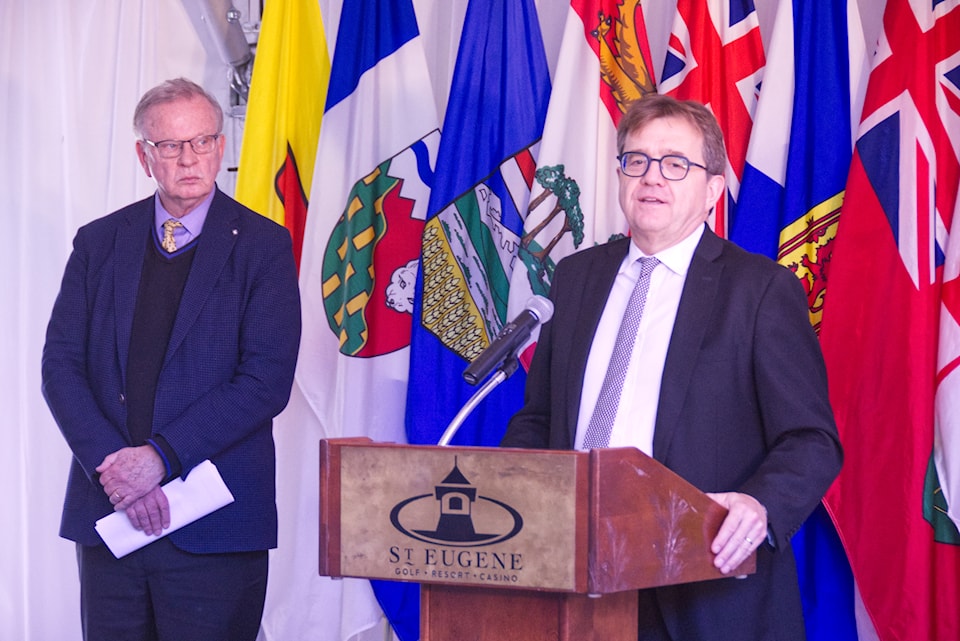Provincial forestry minsters endorsed a new wildfire prevention and mitigation strategy during an annual meeting of the Canadian Council of Forest Ministers, which was held at ʔaq'am, a Ktunaxa Nation community north of Cranbrook.
The Canadian Wildland Fire Prevention and Mitigation Strategy is based on four pillars that include enhancing whole-of-society collaboration and coordination, increasing knowledge and understanding, expanding investments in prevention and mitigation, and strengthen First Nations, Métis and Inuit partnerships.
Bruce Ralson, B.C's forests minister, as well as Jonathan Wilkinson, the federal minister of natural resources, announced the strategy during a press conference.
"This is a call to action that encourages cooperation, coordination and problem solving at all levels of government and society. It builds new relationships that strengthens existing partnerships," said Ralston. "It represents the voices of people across Canada and acknowledges their views and experiences. It recognizes and respects the relationship that Indigenous People have had with fire on the landscape for millennia and ensures that their diverse and unique perspectives are a central pillar to wildfire prevention and mitigation."
The strategy recognizes the importance of mobilizing whole-of-society actions towards wildland fire resilience, said federal natural resources minister Jonathan Wilkinson.
"The severity of wildfires in Canada in recent years underscores the urgency of this strategy and highlights why we must continue to prevent and mitigate the risks of wildland fires before they occur," Wilkinson said. "Our homes, our communities and our environment depend on it."
The strategy is light on specific action item details, however, next steps include developing a collective implementation plan, which will involve local governments, Indigenous communities, industry, and the private sector.
The plan also has targets over the next two years, which include creating an implementation committee and a public awareness campaign on wildfire mitigation initiatives this year.
The goals evolve to targeted training across jurisdictions, industries and communities to strengthen expertise in prevention and mitigation. By 2026, the targets include increasing investments in prevention and mitigation activities and incentive programs, along with tracking and reporting the outcomes of those investments.
"One of things that the strategy does that I think is new is identifies specific targets, so the percentage of people who are actually aware of some of these issues, the percentage of people who have taken action to ensure their homes are prepared, the percentage of communities that have actually developed a detailed plan with respect to fire prevention," said Wilkinson.
"Those are things that are going to be public milestones that we are going to have to work our way towards; every jurisdiction is going to have to work their way towards. We are now moving into that implementation phase and Canadians are going to be able to hold their governments accountable for the progress that is made over the coming years."
Wildfire season is already underway in B.C., particularly in the northeast as Fort Nelson was evacuated due to the Parker Lake wildfire, is now considered under control after growing to over 12,000 hectares.
Coming off the worst wildfire season in provincial history last year, the forecasts for this summer are predicting more dry conditions amid drought concerns, given the state of the low snowpack. Ralson said that in order for the effects of drought to disappear, the province would need 15 centimetres of rain for 60 days.
"People need to be ready, they need to have their own individual plans, but be assured that the Government of British Columbia and the B.C. Wildfire Service are ready to assist," Ralson said.
Over the course of the conference, ministers received a progress report on continued work to define forest degradation, including engagement with key partners and Indigenous organizations, to develop a robust, science-based and transparent reporting framework.
Wilkinson defined forest degradation as direct human impacts to forest landscapes which result in an enduring reduction in, or a reduced capacity to provide ecosystem services."
Ministers also agreed to a strategic program of work to maximize Canada’s effectiveness in informing and influencing the development of forest degradation definition and indicators by international authoritative bodies, impacting Canada’s market access and environmental reputation.
